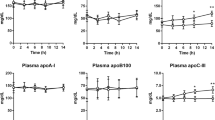Abstract
During fat absorption, unsaturated long chain fatty acids are esterified at a higher rate than saturated fatty acids of similar chain length. This phenomenon has been attributed to differences in the binding affinity of fatty acids to a cytosolic fatty acid-binding protein. As intestinal mucosa utilizes plasma free fatty acids as well, we investigated whether long chainplasma free fatty acids of different degree of saturation are metabolized also at different rates.3H-Palmitic and14C-linoleic acid complexed to rat serum were injected rapidly into a tail vein of fasting rats. One, 2 and 4 min later there was no difference between3H and14C-radioactivity in intestinal mucosa, suggesting equal initial uptake of the two labeled fatty acids from plasma. Despite their equal uptake, the incorporation of the isotopes into ester lipids was significantly different, however: at 2 min, 53.1±3.9% of3H and 73.8±4.6% of14C were recovered in ester lipids. Phospholipids and triglycerides accounted for most of the mucosal3H and14C. At 4 min, a similar distribution of isotopes in intestinal mucosal metabolites was found. These data show that despite equal initial uptake by intestinal mucosa unsaturated long chain fatty acids taken up from plasma are esterified to a higher and oxidized to a lower extent than saturated plasma free fatty acids. Unsaturated plasma free fatty acids, therefore, may provide a more important source of fatty acids for endogenous intestinal lipoprotein lipids than saturated plasma free fatty acids. It is speculated that the fatty acid binding protein might be operative not only in the intracellular transport and metabolism of luminal fatty acids but of plasma free fatty acids as well.
Similar content being viewed by others
References
Havel, R.J., and A. Goldfien, J. Lipid Res. 2:389 (1961).
Baxter, J.H., J. Lipid Res. 7:158 (1966).
Mistilis, S.P., and R.K. Ockner, J. Lab. Clin. Med. 80:34 (1972).
Gangl, A., and R.K. Ockner, J. Clin. Invest. 55:803 (1975).
Gangl, A., and F. Renner, Gastroenterology 74:847 (1978).
Gangl, A., and R.K. Ockner, Gastroenterology 68:167 (1975).
Ockner, R.K., J.P. Pittman, and J.L. Yager, Gastroenterology 62:981 (1972).
Ockner, R.K., and J.A. Manning, J. Clin. Invest. 54:326 (1974).
Ockner, R.K., and J.A. Manning, J. Clin. Invest 58:362 (1976).
Gangl, A., J. Mlczoch, and B. Mursec, 10th Internat. Congr. Gastroent., Budapest, Abstracts I, 134 (1976).
Gangl, A., W. Kornauth, J. Mlczoch, and B. Klose, Z. Gastroenterol. Sonderheft mit Kurzfassungen der 33. Tagung der Deutschen Ges. f. Verd. u. Stoffwkhtn, Abstrakt Nr. 113 (1978).
Folch, J., M. Lees, and G.H. Sloane-Stanley, J. Biol. Chem. 226:497 (1957).
Regouw, B.J.M., P.J.H.C. Cornelissen, R.A.P. Helder, J.B.F. Spijkers, and Y.M.M. Weebers, Clin. Chim. Acta 31:187 (1971).
Morrison, W.R., and L.M. Smith, J. Lipid Res. 5:600 (1964).
Eggstein, M., and F.H. Kreutz, Klin. Wochenschr. 44:262 (1966).
Author information
Authors and Affiliations
About this article
Cite this article
Gangl, A., Kornauth, W., Mlczoch, J. et al. Different metabolism of saturated and unsaturated long chain plasma free fatty acids by intestinal mucosa of rats. Lipids 15, 75–79 (1980). https://doi.org/10.1007/BF02533879
Received:
Issue Date:
DOI: https://doi.org/10.1007/BF02533879




